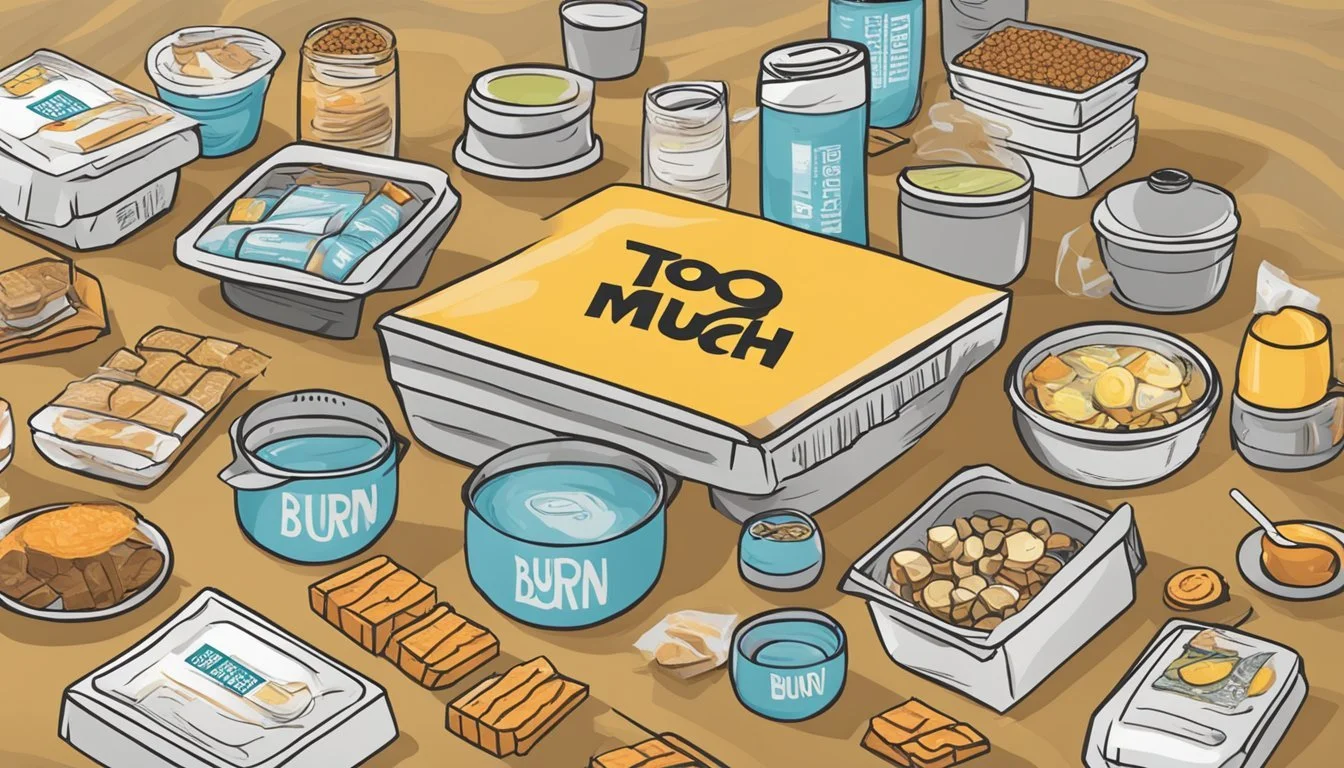How Many Servings of Burn is Too Much
Understanding Safe Consumption Limits
Navigating the delicate balance of protein intake can be crucial for individuals recovering from burn injuries. For adults, protein requirements increase significantly, with recommendations ranging between 1.5 to 2.0 grams per kilogram of body weight. Children, on the other hand, need even more, ranging from 2.5 to 4.0 grams per kilogram daily.
Exceeding these protein recommendations by a large margin may not provide additional benefits and can potentially cause undue strain on the kidneys. It is essential to pair high-protein foods with a well-rounded diet including fruits, vegetables, and grains to support overall recovery and health.
A balanced approach not only ensures adequate healing but also prevents complications associated with excessive protein intake. Keeping a watchful eye on the proportion and quality of protein in meals helps maintain optimal health and recovery progress post-burn injury.
Understanding Servings and Dietary Recommendations
A proper understanding of servings and dietary recommendations ensures a balanced nutrient intake, particularly crucial when recovering from burns. Accurate serving information helps individuals meet their caloric and nutritional needs effectively.
Determining Daily Servings
Daily servings vary based on factors like age, weight, height, and activity level. For burn patients, increased caloric intake is essential due to the hypermetabolic state induced by the injury.
Recommended daily servings from different food groups include:
Breads, grains, cereals: 6-11 servings
Vegetables: 3-5 servings
Fruits: 2-4 servings
Meat, poultry, beans, nuts, fish: 3-4 servings
Dairy products (milk, yogurt, cheese): 3-4 servings
Each food group contributes vital nutrients necessary for wound healing, such as proteins, vitamins, minerals, and antioxidants like Vitamin C and Zinc.
Role of a Dietitian in Diet Planning
A dietitian plays a key role in developing a tailored dietary plan for burn patients. They assess individual needs considering the burn size, current health status, and personal preferences.
Dietitians ensure dietary plans are comprehensive, promoting:
Adequate protein intake for tissue repair
Balanced intake of vitamins and minerals vital for immune support and healing
Appropriate caloric intake to meet increased energy demands
Consulting a dietitian helps prevent deficiencies, supports optimal recovery, and maintains overall health during the healing process. Working with a professional assures a balanced diet, facilitating effective recovery and long-term health.
Interpreting the Nutrition Content in Burn Products
Understanding the nutritional composition of Burn products is essential for managing dietary intake effectively, especially regarding caloric content, sweeteners, and overall nutritional value.
Caloric Content and Weight Management
Calories in Burn products play a significant role in weight management. Each Burn product contains a specific amount of calories often derived from carbohydrates and fats.
For someone monitoring their weight, it's crucial to note the caloric density per serving. Typical values could range around:
Calories: 100-150 per serving
Fat: 1-2 grams
Carbohydrates: 20-30 grams
Protein: 2-3 grams
Balancing these nutrients according to one’s dietary needs helps in maintaining optimal health.
Sugars and Alternative Sweeteners
Sugar content in Burn products varies, impacting both taste and health. Many Burn products use alternative sweeteners to decrease the overall sugar content while maintaining sweetness.
Sugar: 10-15 grams per serving
Alternative Sweeteners: May include stevia, aspartame, or sucralose
Understanding the source and quantity of sugar is beneficial, especially for individuals looking to reduce their sugar intake due to health concerns.
Nutritional Value and Health Benefits
Evaluating the nutritional value involves looking at vitamins, minerals, fiber, and protein content. Burn products often boast a variety of these nutrients to support overall health.
Vitamins: Commonly include Vitamin C, B Vitamins
Minerals: Frequently contain calcium, magnesium, potassium
Fiber: Ranges from 1-5 grams per serving
Protein: Essential for muscle repair and can be 5-10 grams per serving in protein-enriched options
These nutrients contribute to beneficial health outcomes, such as improved immune function and energy levels. Keeping an eye on these aspects can lead to making more informed dietary choices.
Health Impact of Overconsumption
Consuming too much Burn can lead to a range of serious health issues, ranging from metabolic disturbances to chronic diseases. It's crucial to understand the specific risks and how nutritional imbalances can affect overall health.
Risks Associated with Excessive Intake
Excessive intake of Burn can significantly elevate blood sugar levels, contributing to insulin resistance and type 2 diabetes. High sugar content can also lead to rapid weight gain, increasing the risk of obesity. This condition is a precursor to several chronic diseases, including heart disease and hypertension.
Moreover, overconsumption can result in elevated blood pressure and bad cholesterol levels. Excess sugar and calories strain the cardiovascular system, leading to a higher incidence of heart disease. Regular intake in large quantities can also disrupt metabolic functions, leading to long-term health complications.
Nutritional Imbalance and Deficiencies
Consuming too much Burn may displace essential nutrients in one's diet. High sugar and calorie content can lead to reduced intake of critical vitamins and minerals. This imbalance can weaken the immune system and make the body more vulnerable to infections and diseases.
Additionally, too much sugar can deplete essential B vitamins, which are crucial for energy metabolism. Lack of these nutrients can result in fatigue and weakened cognitive function. Frequent and high intake of Burn disrupts normal dietary patterns, leading to deficiencies that affect overall health and well-being.
Guidelines for Various Demographic Groups
When considering how many servings of Burn is appropriate, it's crucial to account for factors such as age, sex, and physical activity levels. Different demographic groups require varied nutritional needs and calorie intake.
Nutritional Needs by Age and Sex
Children and Adolescents: Young people need ample nutrients to support growth and development. Generally, 1-2 servings of Burn per day can be beneficial, but it should be balanced with other nutrient-dense foods. Boys and girls have similar needs until puberty.
Adults: Adult requirements differ by sex and life stage. Men typically need more calories than women due to higher muscle mass. For women, especially during pregnancy or breastfeeding, nutrient needs increase, so 2 servings might be more suitable.
Older Adults: Metabolism slows with age, reducing calorie needs. 1 serving of Burn daily can provide essential nutrients without excessive calories. Protein needs may increase slightly to maintain muscle mass.
Adjusting Intake Based on Physical Activity
Sedentary Individuals: Those with minimal physical activity should consume fewer servings to avoid excess calories. 1 serving of Burn daily can be adequate for maintaining nutritional balance.
Moderately Active Individuals: People who engage in moderate physical activity (e.g., walking, light exercise) require additional nutrients. 1-2 servings of Burn can support their increased energy needs without overconsumption.
Highly Active Individuals: Athletes or those with rigorous physical routines often need more calories and protein. They might benefit from 2-3 servings of Burn each day to match their higher energy expenditure and promote muscle recovery.
Professional and Scientific Perspectives
Experts offer vital knowledge on how burn survivors should manage their nutrition to promote healing and avoid complications. Key insights from both registered dietitians and scientific research help shape an understanding of optimal feeding practices.
Insights from Dietitians and Nutritionists
Registered dietitians emphasize the importance of tailored nutrition plans for burn patients. They recommend high-protein diets to support tissue repair and immune function.
Energy intake must be significantly increased due to elevated metabolic demands. Dietitians also stress the need for micronutrient supplementation, such as vitamins and minerals, to counteract deficiencies that hinder recovery.
The frequency and quantity of meals should be adjusted to prevent muscle loss and boost overall energy levels. Small, frequent meals containing a balance of macronutrients—proteins, fats, and carbohydrates—are optimal.
Scientific Research on Servings and Health
Research highlights dramatic changes in metabolism post-burn, necessitating higher caloric intake. Studies document that failing to meet these requirements can lead to multiorgan dysfunction and increased susceptibility to infections.
Burn patients can lose up to 25% of their body mass, making nutritional support critical. Studies suggest that high insulin levels in patients help conserve muscle protein, albeit partially.
Global epidemiological data show significant morbidity and mortality from burns, underscoring the need for adequate nutritional interventions. The hypermetabolic response following burns greatly influences both energy and protein requirements to improve survival rates.
Balancing Diet with Physical Exercise
Balancing your diet with physical exercise is crucial for maintaining a healthy lifestyle. It helps regulate weight, improve cardiovascular health, and enhance muscle mass.
Exercise's Role in Neutralizing Excess Calories
Physical activity is vital for burning excess calories from the diet. Activities like cardio, walking, and standing can significantly increase caloric expenditure.
Cardio exercises such as running, cycling, and swimming are effective for burning calories and improving heart health.
Walking and standing also contribute, especially for individuals with sedentary jobs.
Increasing muscle mass through resistance training raises the basal metabolic rate (BMR), meaning more calories are burned even at rest.
Integrating Regular Activity for Optimal Health
Consistent physical activity supports overall well-being and dietary balance. Integrate a mix of aerobic and anaerobic exercises to maximize health benefits.
Regular activity can include moderate exercises like brisk walking or more intense workouts like high-intensity interval training (HIIT).
Aim for at least 150 minutes of moderate aerobic activity each week.
Incorporate strength training exercises at least twice weekly to build muscle and enhance metabolism.
This balanced approach ensures the body effectively uses and burns the calories consumed, promoting sustained health.
Impact of Lifestyle and Environmental Factors
Various lifestyle choices and environmental influences can significantly impact how many servings of Burn you consume. These elements can range from stress levels to social settings, all of which play a crucial role in dietary decisions.
Everyday Habits Affecting Dietary Decisions
Daily routines and habits are critical in determining nutritional patterns. Stress and mood often lead individuals to consume larger quantities of comfort food and beverages, including energy drinks like Burn.
Skipping meals or eating at irregular times can result in an imbalance, making excessive intake more likely. Sleep patterns also affect metabolism and cravings, influencing how much one tends to drink. Hence, maintaining a balanced lifestyle helps manage intake effectively.
Environmental Influence on Consumption Patterns
Environmental factors, such as social settings and work environments, heavily dictate consumption behaviors. People are more likely to consume more servings when surrounded by peers who frequently drink energy beverages.
Advertising and product availability further increase chances of overconsumption. Genetics and existing health problems also play roles, as they can alter how susceptible someone is to external influences. A less supportive environment can lead to unhealthy consumption patterns.
Table: Factors Affecting Servings of Burn
Factor Influence Stress Increases craving Sleep Affects metabolism Social Settings Peer pressure Advertising Influences choice Health Problems Alters susceptibility
Managing these factors can help in controlling how many servings of Burn are optimal.
Smart Eating Strategies for Sustainable Health
Adopting smart eating strategies can significantly impact sustainable health. Key components include incorporating a variety of nutritious foods and creating a calorie deficit while staying nourished.
Incorporating a Variety of Nutritious Foods
A diverse diet supports overall health and helps in weight loss. Fruits and vegetables provide essential vitamins, minerals, and fiber which are crucial for a healthy digestive system. Including a variety of whole grains like oats, brown rice, and quinoa ensures a steady energy supply and promotes satiety.
Lean meats and dairy are important sources of protein and calcium. Opt for skinless poultry, fish, and low-fat dairy products to reduce saturated fat intake. Snacks should be nutrient-dense; consider fruits, nuts, or plain yogurt.
Limit the consumption of fruit juices to avoid excess natural sugars. Eating whole fruit is preferable as it provides fiber and helps in feeling full longer. Diversifying your food choices ensures a balanced intake of nutrients vital for sustaining health.
Creating a Calorie Deficit While Staying Nourished
For weight loss, a calorie deficit is necessary, yet nourishing the body remains critical. Aim to reduce caloric intake from processed foods high in sugars and unhealthy fats. Replace them with filling foods rich in fiber, such as vegetables and whole grains. These foods offer volume and fullness with fewer calories.
Regularly consume lean proteins to maintain muscle mass. Chicken breast, legumes, and tofu are excellent options. Dairy products like Greek yogurt can also be part of meals and snacks without adding excessive calories.
Balancing macronutrients—carbohydrates, proteins, and fats—ensures the body receives sustained energy. Prioritize foods that offer natural sugars rather than refined ones. Smart snacking through the day with fruits and nuts can prevent overeating at main meals, aiding in sustainable weight loss.
Understanding Supplements and Enhanced Products
Supplements and enhanced food products play a crucial role in providing essential nutrients that can support overall health and recovery. From vitamins to omega-3 fatty acids, these products aim to fulfill dietary needs that regular food might not completely cover.
Role of Dietary Supplements in Nutrition
Dietary supplements are used to provide nutrients that individuals might not get sufficiently from their daily diet. Common supplements include vitamins, minerals, and omega-3 fatty acids. For instance, vitamin D is essential for bone health and calcium absorption, while vitamin B12 is crucial for nerve function.
Fiber supplements can aid in digestion and prevent constipation, which is often a concern for individuals with restricted diets. When choosing supplements, it's vital to consider the recommended daily allowances and consult healthcare professionals to avoid excessive intake, which can lead to adverse health effects.
Examining the Need for Enhanced Food Products
Enhanced food products are designed to meet the specific nutritional needs of individuals with different health conditions. These products often contain added vitamins, minerals, and other beneficial compounds. For example, milk fortified with calcium and vitamin D supports bone health, while cereals enriched with B vitamins and iron help in maintaining energy levels.
Food products enhanced with omega-3 fatty acids can support cardiovascular health, and those with added vitamin C and zinc can boost immune function. Assessing the need for such products involves understanding individual dietary deficiencies and consulting with nutrition experts to ensure proper nutrition is achieved without over-reliance on any single product.










